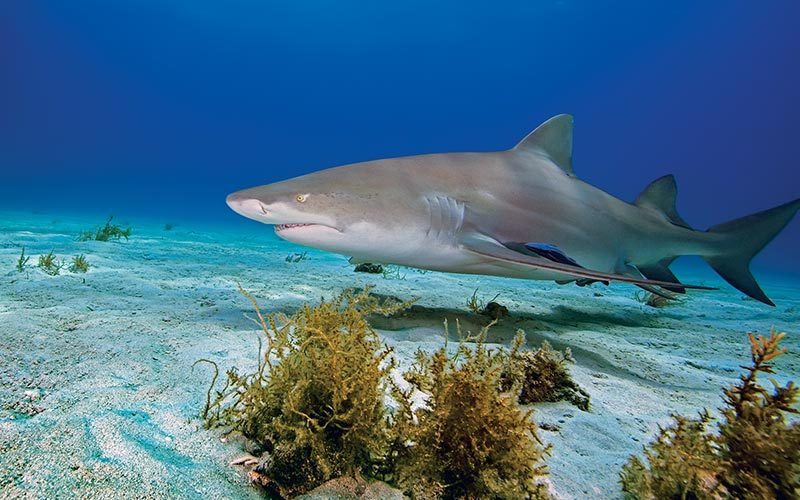The Sargasso Sea, a 1.5-million-square-mile circle of ocean filled with vast rafts of free-floating algae, occupies the North Atlantic Subtropical Gyre, a large system of rotating currents within the Atlantic. The Sargasso Sea is bounded by the Gulf Stream, the North Atlantic current, the Canary Current and the North Atlantic Equatorial Current, and it has inspired ancient poets, mariners’ tales, 20th-century science fiction and even music videos. “Sailing ships were afraid of becoming trapped in it,” said Larry McKinney, executive director of the Harte Research institute for Gulf of Mexico Studies at Texas A&M University-Corpus Christi. “I’ve been in sargassum mats so thick … the size of 10 football fields, I could almost imagine that happening.”
Far from being hazardous, sargassum plays a significant role in the marine ecosystem, providing a variety of habitats that include resting, feeding and breeding areas for many species. The young of four types of sea turtles — loggerhead, hawksbill, Kemp’s ridley and green — hide from predators in the mats and eat both the algae and creatures that live in it. (They and other creatures also eat plastic bits that collect in the mats, sometimes with deadly consequences.)
More than 100 species of fish spawn in the Sargasso Sea, including white marlin, porbeagle shark, dolphinfish and eels, and the mats shelter larval forms of billfish, flying fish and many other species. More than 150 invertebrates are associated with sargassum. Ten species endemic to the environment (which include fish, mollusks and crustaceans) are camouflaged to match the surroundings. The sargassumfish even has modified fins that allow it to crawl through the seaweed.

McKinney likens sargassum to a huge, moving nursery for open-water megafauna. “Inshore, these organisms hide and grow in wetlands, bays and estuaries, and sargassum plays that role out in the open ocean,” he said. “You have transients — the juveniles that hide there to grow and then move into the open ocean. You have resident populations, which have evolved together with the algae over millions of years. And hanging around the edges of these mats are the predators, waiting to pounce on anything that comes out.”
Humpback whales pass through the Sargasso Sea on their annual migrations, as do birds and commercially valuable fish such as tuna, all depending on it for food. Particulate rains from sargassum mats to nourish creatures in the ocean’s depths; depending on when and where mats sink, they may represent the bulk of that marine snow. “The open sea is like a desert, and sargassum is an oasis in that desert,” said Blair Witherington, a research scientist with the Florida Fish and Wildlife Conservation Commission’s Fish and Wildlife Research Institute.
The algae is even an important part of coastal ecosystems. Wind blows it onto beaches, where it helps anchor sand and contributes nutrients. While other seaweeds reproduce and begin life on the seafloor, sargassum floats and grows vegetatively, with new mats produced from parts of the parent organism rather than from seeds or spores. “That makes the Sargasso Sea essentially one enormous super-organism,” Witheringon said.
According to a 2008 study, most new growth in the Sargasso Sea occurs in the northwest Gulf of Mexico, where sargassum grows rapidly in the spring. It then travels via the Loop Current into the Atlantic, where it accumulates in the gyre. The Gulf produces about a million tons of sargassum a year, McKinney said, and at any given time between 4.5 and 12 million tons of it bob in the Gulf and Atlantic. An individual mat lives about a year or possibly two, starting out bright orange and gradually becoming brown as it ages. It eventually loses its buoyancy and sinks.

Sargassum’s abundance waxes and wanes and can be hard to measure; storms sink it, currents break it up and move it, and nutrients make it grow. Some worry that it is in decline, but McKinney said there is little scientific evidence of that. A recent study analyzed images from the Medium Resolution Imaging Spectrometer (MERIS), a satellite launched by the European Space Agency, to measure abundance of sargassum from 2002 to 2008. The images showed an increased abundance in 2008 compared to 2002 and a maximum abundance in 2005.
That could change, however. As recently as the late 1990s, tons of sargassum were harvested for use in animal feed and as fertilizer. Given its importance as habitat, the U.S. South Atlantic Fishery Management Council set a commercial annual catch limit of 5,000 pounds and prohibited harvesting within 100 miles of shore, effectively halting commercial harvesting. However, the council’s authority only covers U.S. waters off North and South Carolina, Georgia and eastern Florida. Elsewhere in the U.S. and on the high seas, where most sargassum is found, the algae has no protection. The Sargasso Sea Alliance, a collaboration led by the government of Bermuda and including the World Wildlife Fund, Sylvia Earle’s Mission Blue and the Marine Conservation Institute, is working on a mechanism to protect and manage what it calls “the golden floating rainforest.” New potential uses for sargassum, including pharmaceuticals and biofuel, make the need to protect it more urgent, as do increasing threats such as climate change, ship traffic and pollution.
Those who have been diving around mats of sargassum say they make excellent dive sites because of the many critters living in them and the predators that hang out around them. “Diving under sargassum is like diving in another world,” said Billy Causey, Southeast Regional Director for NOAA’s Office of Marine Sanctuaries. “If you can’t get out on a reef, it’s just as good.”
Explore More
© Alert Diver — Q2 Spring 2013